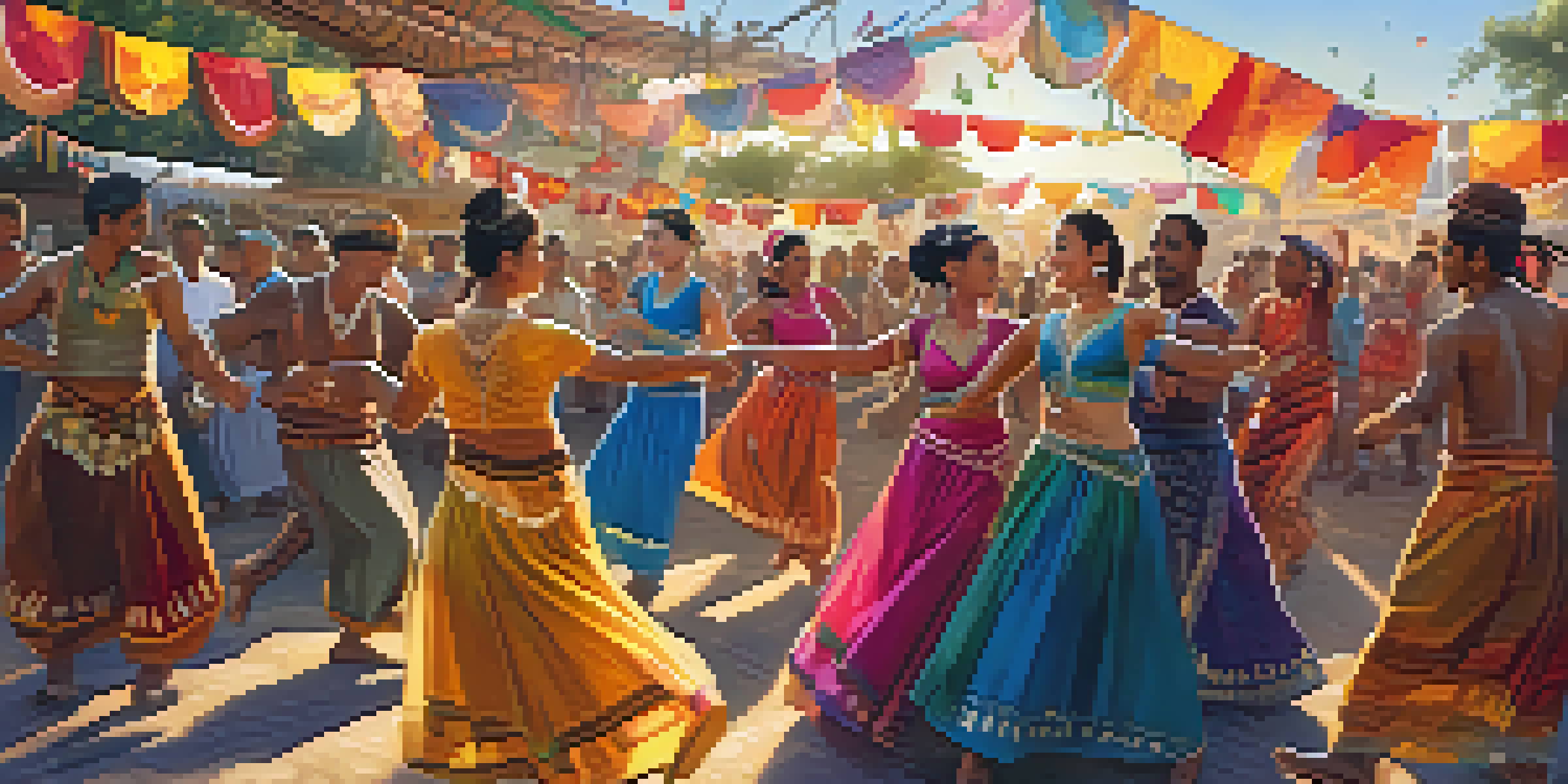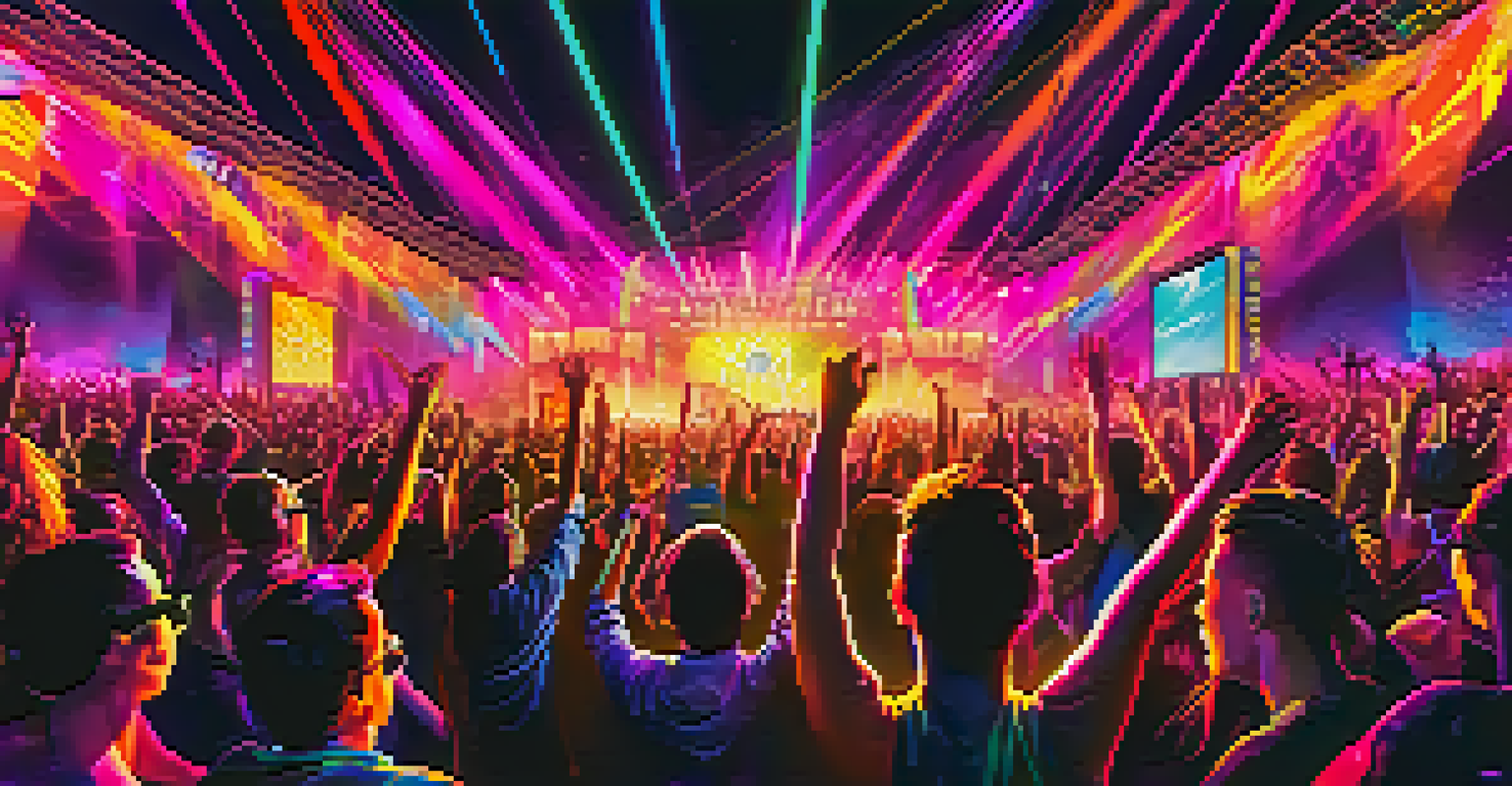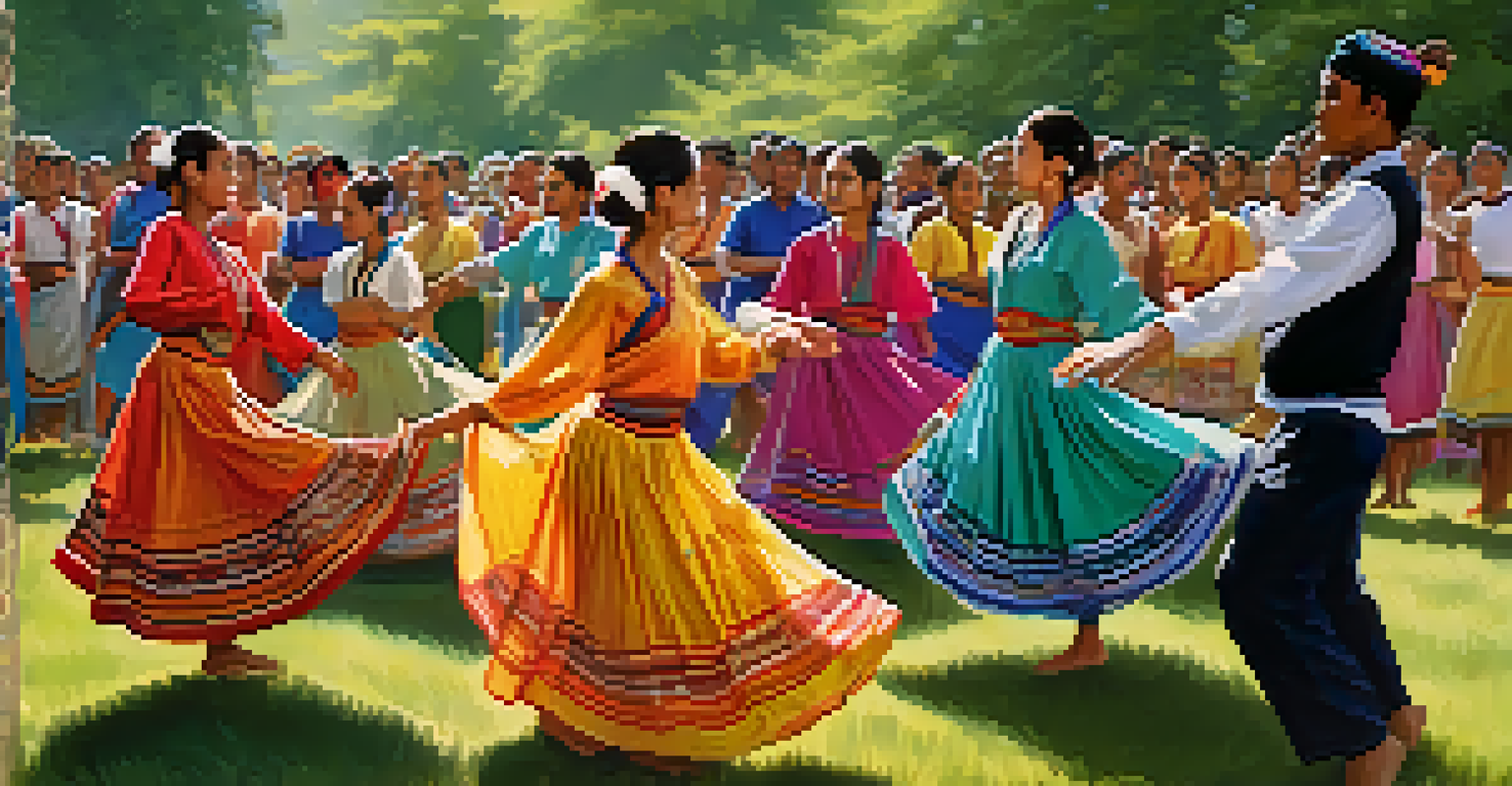History and Evolution of Dance Festivals Worldwide

The Origins of Dance Festivals: A Cultural Exploration
Dance festivals have roots that stretch back to ancient civilizations, where they were often intertwined with religious ceremonies and community gatherings. For instance, in ancient Greece, the Dionysia festival celebrated the god Dionysus with theatrical performances and dances, showcasing the importance of movement in cultural expression. These early festivals served not just for entertainment, but as a means to strengthen community bonds and celebrate shared beliefs.
Dance is the hidden language of the soul.
As societies evolved, so did the nature of these festivals. By the Middle Ages, festivals became more secular, incorporating folk dances that reflected the daily lives of the people. Towns would host seasonal celebrations, where dance was a form of storytelling, often highlighting local legends and traditions. This transition from spiritual to communal celebration marked a pivotal moment in the evolution of dance festivals, making them accessible to wider audiences.
Today, the legacy of these ancient celebrations can be seen in various forms around the world, from traditional folk festivals to modern electronic dance music (EDM) events. The essence of gathering to dance, celebrate, and connect remains a common thread, showing how deeply rooted these festivals are in our human experience.
Dance Festivals in the 20th Century: A New Era
The 20th century brought about a significant transformation in dance festivals, particularly with the rise of global communication and cultural exchange. Events like the Montreux Jazz Festival, established in 1967, not only showcased diverse music but also introduced dance as an integral part of the celebration. This period marked a shift where festivals began to embrace multiple genres and styles, reflecting the eclectic tastes of a rapidly changing world.

Additionally, the emergence of dance styles such as hip-hop and contemporary dance influenced festival programming. Street dance competitions and performances started to gain prominence, allowing new generations of dancers to express themselves in ways that resonated with their experiences. Festivals became platforms for cultural dialogue, where different dance forms could be celebrated and explored.
Dance Festivals: A Historical Journey
Dance festivals have evolved from ancient religious ceremonies to modern celebrations of diverse cultural expressions.
As dance festivals grew in popularity, they also began to attract international audiences, paving the way for iconic events like the Edinburgh Festival Fringe and the Cannes Dance Festival. These festivals not only spotlighted established artists but also provided a stage for emerging talent, fostering creativity and innovation in the dance community.
The Role of Technology in Modern Dance Festivals
In the digital age, technology has dramatically reshaped the landscape of dance festivals. From live streaming performances to the use of social media for promotion, organizers now have tools to reach a global audience like never before. This democratization of access means that even those unable to attend in person can still experience the magic of dance festivals from their homes.
The dance is a poem of which each movement is a word.
Moreover, advancements in sound and lighting technology have elevated the festival experience, creating immersive environments that captivate audiences. Festivals like Coachella and Tomorrowland utilize cutting-edge technology to enhance performances, making the visual and auditory experience as exhilarating as the dance itself. This integration of tech and artistry has set new standards for what attendees can expect.
However, this reliance on technology also poses challenges, such as ensuring that the human element of dance remains at the forefront. As festivals continue to evolve, striking a balance between innovation and authenticity will be crucial to preserving the essence of dance as a vital form of expression.
Globalization and Its Impact on Dance Festivals
Globalization has played a pivotal role in shaping modern dance festivals, allowing cultures to intermingle in exciting ways. Festivals now frequently feature diverse dance forms from around the world, such as Bollywood, African dance, and ballet, reflecting a rich tapestry of cultural influences. This melting pot of styles not only enriches the festival experience but also fosters understanding and appreciation among different communities.
Events like the World Dance Alliance showcase international talent and encourage cross-cultural collaboration, proving that dance is a universal language. By bringing together artists from various backgrounds, these festivals promote dialogue and creativity, allowing individuals to celebrate differences while discovering common ground through movement. This spirit of inclusivity is essential in today’s global society.
Technology's Impact on Festivals
Advancements in technology have transformed dance festivals, enhancing audience experiences while posing challenges to maintain authenticity.
However, as diverse as these festivals have become, there is also a growing concern about cultural appropriation. Festivals must navigate the fine line between celebrating different cultures and respecting their origins, ensuring that all performances honor the traditions they represent. This awareness is crucial in fostering a respectful and enriching environment for both performers and audiences.
The Evolution of Dance Genres at Festivals
The landscape of dance genres at festivals has transformed dramatically over the years, reflecting changing trends and audience interests. From classical ballet to contemporary dance, festivals now encompass a wide array of styles. This evolution allows for a dynamic exploration of movement, where audiences can experience everything from traditional folk dances to cutting-edge experimental performances.
The rise of electronic dance music (EDM) has also spurred a new wave of dance festivals, creating a vibrant culture that attracts millions of fans worldwide. Festivals like Electric Daisy Carnival and Ultra Music Festival have become synonymous with high-energy dance experiences, showcasing not just music but also a unique dance culture that thrives in this environment. The infectious energy of these events fosters a sense of community among attendees, uniting them through shared experiences.
As dance genres continue to evolve, festivals must adapt to keep pace with emerging trends. This adaptability ensures that dance remains relevant and engaging, offering audiences new forms of expression that resonate with contemporary culture. The continual evolution of dance genres is a testament to the art form's resilience and its ability to inspire and connect people across generations.
The Environmental Impact of Dance Festivals
As dance festivals grow in size and popularity, their environmental impact has become a pressing concern. Large crowds and the resources required to host these events can strain local ecosystems, prompting festival organizers to rethink their approaches. Initiatives aimed at sustainability, such as reducing waste and promoting eco-friendly practices, are becoming increasingly common in the festival circuit.
Many festivals now implement measures like using biodegradable materials, offering recycling stations, and encouraging carpooling among attendees. These efforts not only minimize environmental damage but also raise awareness about sustainability within the dance community. By prioritizing eco-conscious practices, festivals can lead by example, inspiring attendees to adopt more environmentally friendly habits.
Globalization and Cultural Exchange
Globalization has enriched dance festivals by incorporating various dance styles, fostering cultural understanding and appreciation.
Moreover, some festivals are collaborating with local organizations to ensure that their impact is positive, focusing on community engagement and support. This holistic approach not only preserves the environment but also fosters a sense of responsibility among attendees, making them active participants in creating a sustainable future for dance festivals.
The Future of Dance Festivals: What Lies Ahead
Looking ahead, the future of dance festivals is poised for exciting developments. With the continual advancement of technology and the growing emphasis on sustainability, festival organizers have the opportunity to innovate in ways that enhance the attendee experience while being mindful of their impact. Virtual reality and augmented reality could soon play a role in how audiences experience performances, offering immersive experiences that were once unimaginable.
Additionally, the ongoing globalization of dance will likely continue to influence festival programming, with an increasing focus on inclusivity and representation. As audiences become more aware of social issues, festivals may also serve as platforms for advocacy, using dance as a means to raise awareness about important causes. This evolution could deepen the connection between art and activism, making dance festivals even more meaningful.

Ultimately, as dance festivals continue to evolve, their ability to adapt to changing cultural landscapes will determine their relevance. By embracing innovation while honoring tradition, the future of dance festivals holds the promise of deeper connections, vibrant celebrations, and a continued celebration of the diverse tapestry of dance around the world.